A Wavefront Integration Algorithm Based on Radial Basis Function for Off-Axis PMD
Abstract
:1. Introduction
2. Principle
2.1. The Principle of PMD
2.2. The Principle of RBF Integration Method
2.3. Ray Tracing Model
3. Numerical Simulations and Experiments
3.1. Numerical Simulations
3.2. Experimental Results
3.3. KDP Crystal Pre-Surface Testing Based on Off-Axis PMD
4. Discussion and Conclusions
Author Contributions
Funding
Institutional Review Board Statement
Informed Consent Statement
Data Availability Statement
Acknowledgments
Conflicts of Interest
Appendix A
| Methods/Angles | 8° | 11° | 14° | 17° | 20° |
|---|---|---|---|---|---|
| RMS | RMS | RMS | RMS | RMS | |
| Southwell | 6.2796 × 10−4 | 8.9421 × 10−4 | 1.1956 × 10−3 | 1.5453 × 10−3 | 1.9634 × 10−3 |
| RBF | 1.2303 × 10−6 | 1.3114 × 10−6 | 1.5102 × 10−6 | 1.2916 × 10−6 | 1.392 × 10−6 |
| PV | PV | PV | PV | PV | |
| Southwell | 2.751 × 10−3 | 3.8075 × 10−3 | 5.0341 × 10−3 | 6.4804 × 10−3 | 8.2391 × 10−3 |
| RBF | 2.1682 × 10−5 | 2.3822 × 10−5 | 2.3886 × 10−5 | 2.3638 × 10−5 | 2.9017 × 10−5 |
| Methods/Angles | 8° | 11° | 14° | 17° | 20° |
|---|---|---|---|---|---|
| RMS | RMS | RMS | RMS | RMS | |
| Southwell | 1.3774 × 10−4 | 1.0486 × 10−3 | 1.3991 × 10−3 | 1.8042 × 10−3 | 2.2842 × 10−3 |
| RBF | 1.1581 × 10−6 | 1.3097 × 10−6 | 1.2639 × 10−6 | 1.4003 × 10−6 | 1.4558 × 10−6 |
| PV | PV | PV | PV | PV | |
| Southwell | 5.9239 × 10−3 | 8.4416 × 10−3 | 1.1278 × 10−2 | 1.4551 × 10−2 | 1.8427 × 10−2 |
| RBF | 1.8636 × 10−5 | 2.4124 × 10−5 | 2.5955 × 10−5 | 2.4068 × 10−5 | 2.9257 × 10−5 |
| Methods/Angles | 8° | 11° | 14° | 17° | 20° |
|---|---|---|---|---|---|
| RMS | RMS | RMS | RMS | RMS | |
| Southwell | 6.7733 × 10−4 | 9.5299 × 10−4 | 1.2637 × 10−3 | 1.6199 × 10−3 | 2.0353 × 10−3 |
| RBF | 1.2881 × 10−4 | 1.3348 × 10−4 | 1.4040 × 10−4 | 1.4979 × 10−4 | 1.6185 × 10−4 |
| PV | PV | PV | PV | PV | |
| Southwell | 4.8661 × 10−3 | 7.0352 × 10−3 | 9.4538 × 10−3 | 1.2206 × 10−2 | 1.5405 × 10−2 |
| RBF | 8.8785 × 10−4 | 9.0465 × 10−4 | 9.2675 × 10−4 | 9.4235 × 10−4 | 9.4867 × 10−4 |
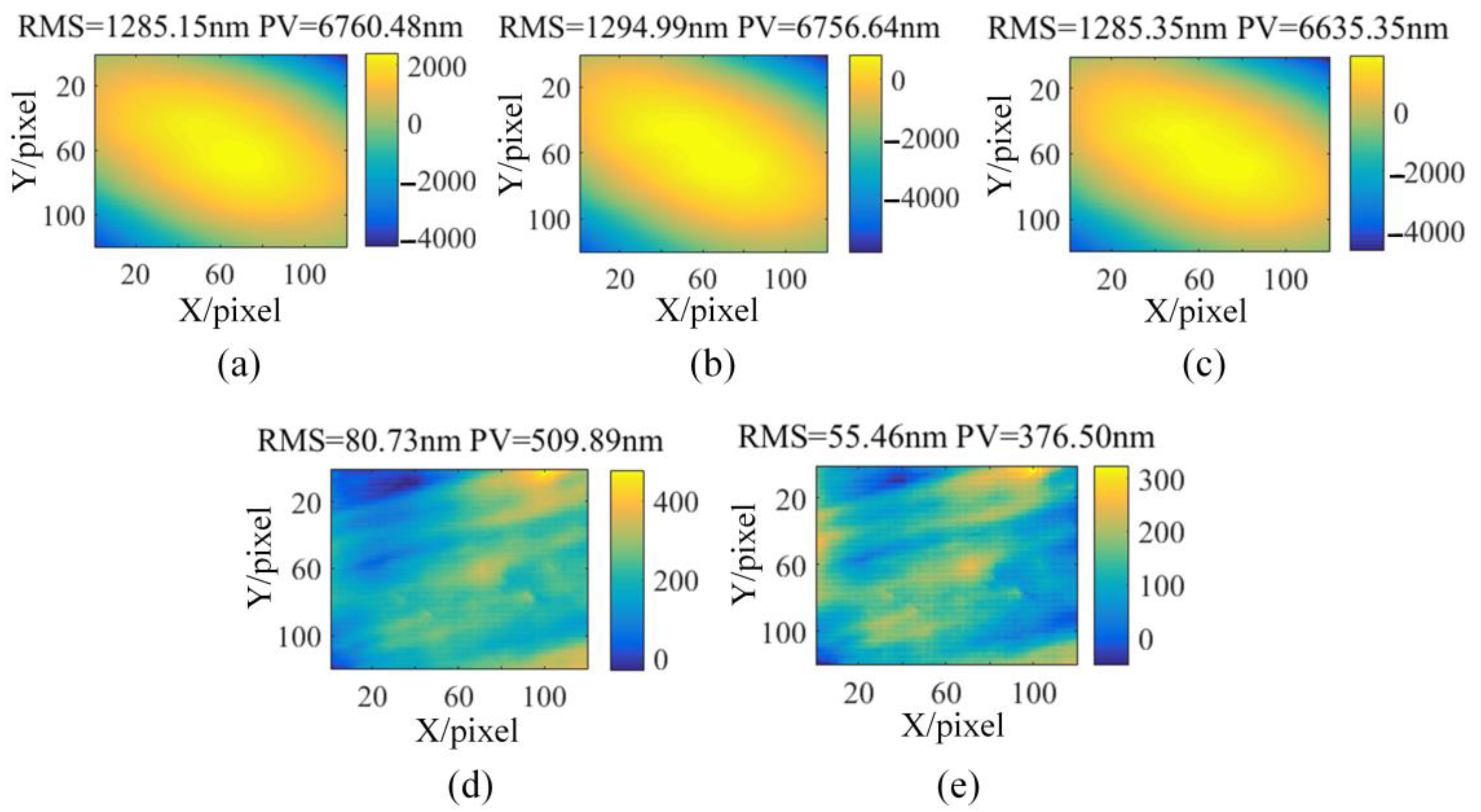

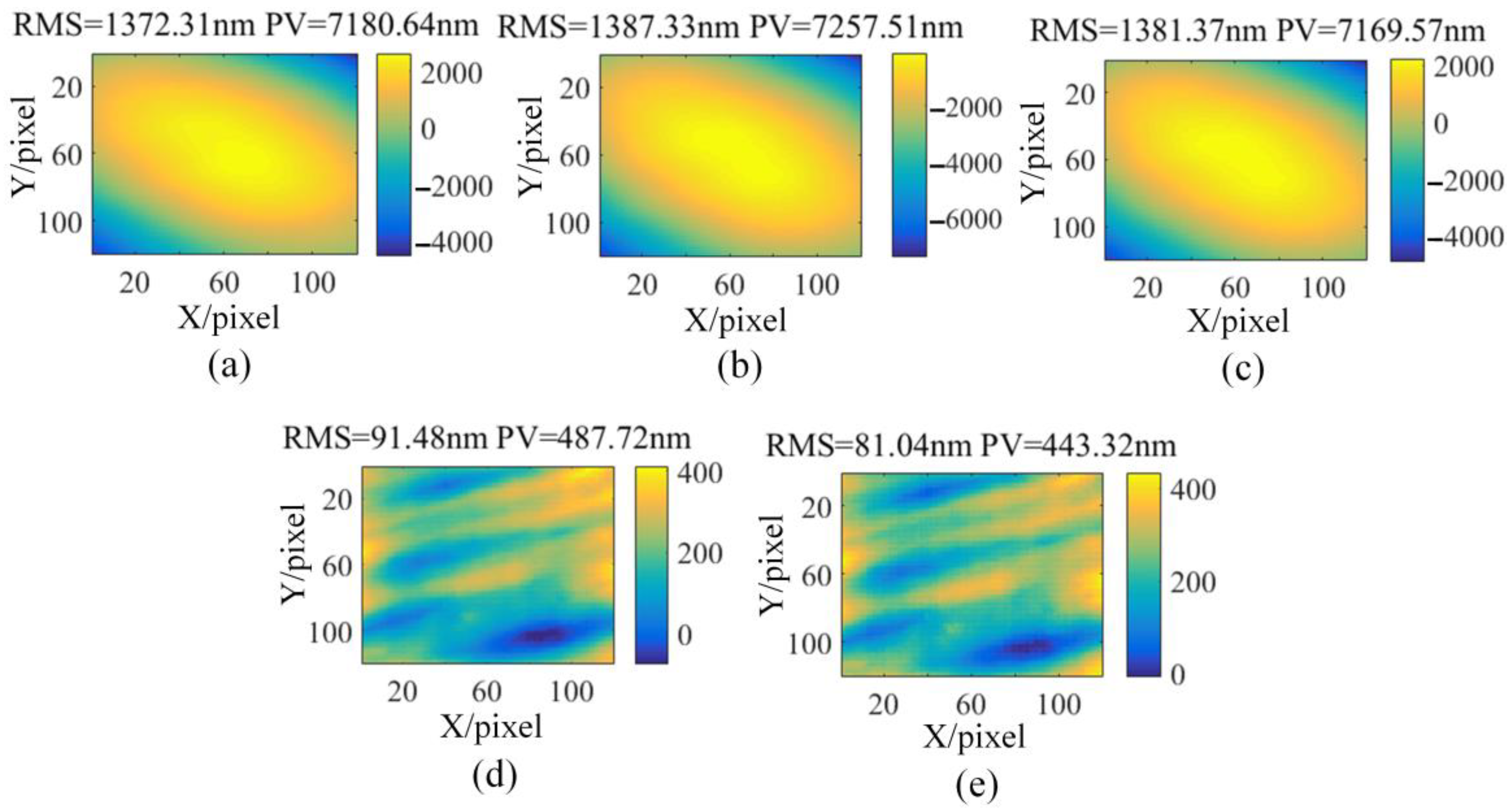
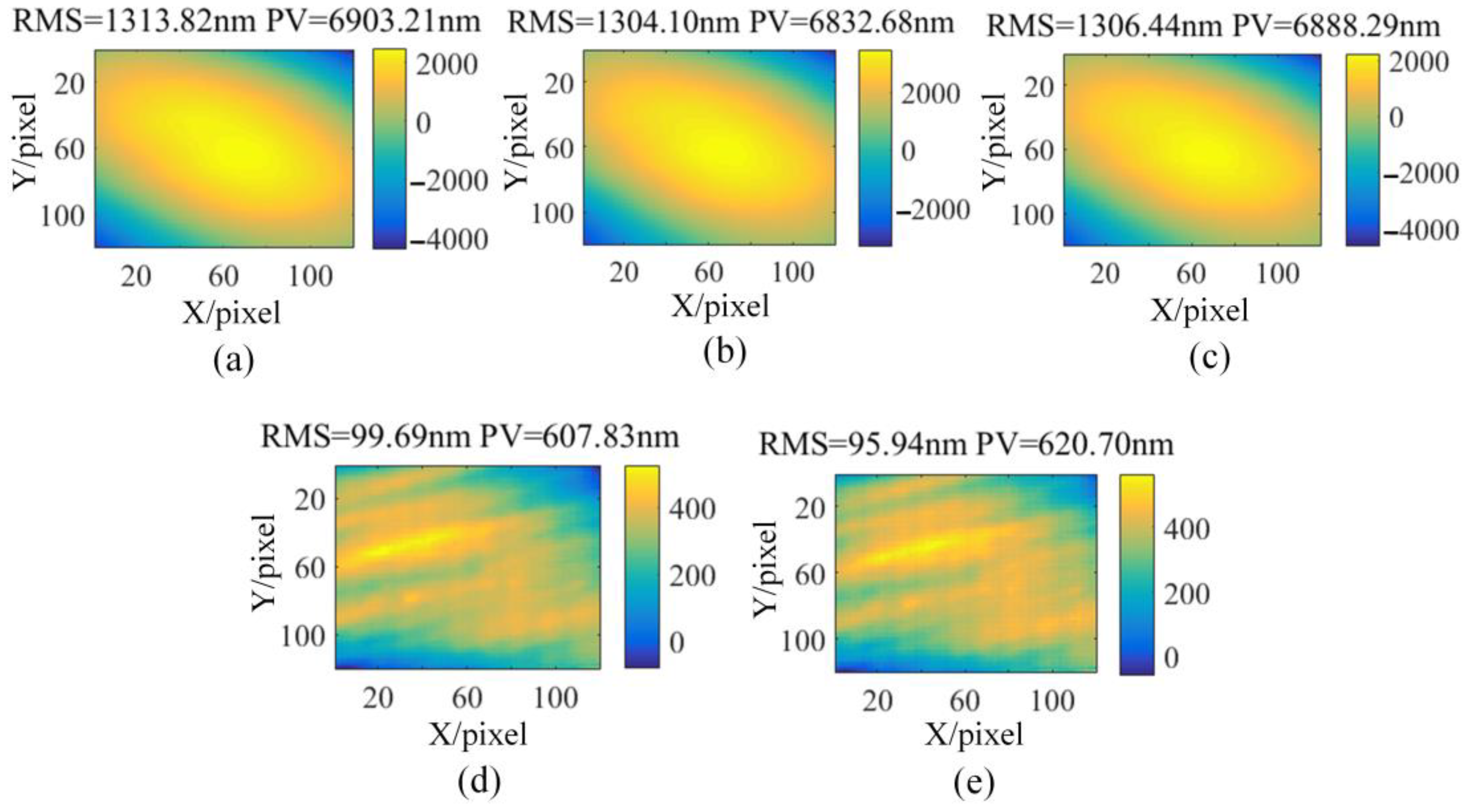
References
- Knauer, M.C.; Kaminski, J.; Häusler, G. Phase measuring deflectometry: A new approach to measure specular free-form surfaces. In Optical Metrology in Production Engineering; SPIE: Bellingham, DC, USA, 2004; pp. 366–376. [Google Scholar]
- Jin, C.; Li, D.; Kewei, E.; Li, M.; Chen, P.; Wang, R.; Xiong, Z. Phase extraction based on iterative algorithm using five-frame crossed fringes in phase measuring deflectometry. Opt. Lasers Eng. 2018, 105, 93–100. [Google Scholar] [CrossRef]
- Huang, L.; Idir, M.; Zuo, C.; Asundi, A. Review of phase measuring deflectometry. Opt. Lasers Eng. 2018, 107, 247–257. [Google Scholar] [CrossRef]
- Burke, J.; Pak, A.; Hfer, S.; Ziebarth, M.; Roschani, M.; Beyerer, J. Deflectometry for specular surfaces: An overview. arXiv 2022, arXiv:2204.11592. [Google Scholar]
- Su, P.; Parks, R.E.; Wang, L.R.; Angel, R.P.; Burge, J.H. Software configurable optical test system: A computerized reverse Hartmann test. Appl. Opt. 2010, 49, 4404–4412. [Google Scholar] [CrossRef]
- Su, P.; Khreishi, M.; Su, T.Q. Aspheric and freeform surfaces metrology with software configurable optical test system: Acomputerized reverse Hartmann test. Opt. Eng. 2014, 53, 031305. [Google Scholar] [CrossRef]
- Xu, Y.; Gao, F.; Jiang, X. A brief review of the technological advancements of phase measuring deflectometry. PhotoniX 2020, 1, 1–10. [Google Scholar] [CrossRef]
- Wang, R.; Li, D.; Xu, K.; Zhang, X.; Luo, P. Parasitic reflection elimination using binary pattern in phase measuring deflectometry. Opt. Commun. 2019, 451, 67–73. [Google Scholar] [CrossRef]
- Huang, R.; Su, P.; Horne, T.; Brusa, G.; Burge, J.H. Optical metrology of large deformable aspherical mirror using software configurable optical test system. Opt. Eng. 2014, 50, 085106. [Google Scholar] [CrossRef] [Green Version]
- Huang, L.; Asundi, A.K. Framework for gradient integration by combining radial basis functions method and least-squares method. Appl. Opt. 2013, 52, 6016–6021. [Google Scholar] [CrossRef]
- Freischlad, K.R.; Koliopoulos, C.L. Modal estimation of a wave front from difference measurements using the discrete Fourier transform. J. Opt. Soc. Am. A 1986, 3, 1852–1861. [Google Scholar] [CrossRef]
- Dai, G.M. Modal wave-front reconstruction with Zernike polynomials and Karhunen–Loève functions. J. Opt. Soc. Am. A 1996, 13, 1218–1225. [Google Scholar] [CrossRef]
- Fried, D.L. Least-square fitting a wave-front distortion estimate to an array of phase-difference measurements. Opt. Soc. Am. 1977, 67, 370–375. [Google Scholar] [CrossRef]
- Southwell, W.H. Wave-front estimation from wave-front slope measurements. J. Opt. Soc. Am. 1980, 70, 998–1006. [Google Scholar] [CrossRef]
- Li, M.; Li, D.; Jin, C.; Kewei, E.; Yuan, X.; Xiong, Z.; Wang, Q. Improved zonal integration method for high accurate surface reconstruction in quantitative deflectometry. Appl. Opt. 2017, 56, F144–F151. [Google Scholar]
- Ettl, S.; Kaminski, J.; Knauer, M.C.; Häusler, G. Shape reconstruction from gradient data. Appl. Opt. 2008, 47, 2091–2097. [Google Scholar] [CrossRef] [Green Version]
- Huang, L.; Idir, M.C.; Chao, Z.; Kaznatcheev, K.; Zhou, L.; Asundi, A. Comparison of two-dimensional integration methods for shape reconstruction from gradient data. Opt. Laser Eng. 2015, 64, 1–11. [Google Scholar] [CrossRef]
- Ren, H.; Gao, F.; Jiang, X. Improvement of high-order least-squares integration method for stereo deflectometry. Appl. Opt. 2015, 54, 10249–10255. [Google Scholar] [CrossRef]
- Ren, H.; Gao, F.; Jiang, X. Least-squares method for data reconstruction from gradient data in deflectometry. Appl. Opt. 2016, 55, 6052–6059. [Google Scholar] [CrossRef] [Green Version]
- Huang, L.; Xue, J.; Gao, B.; Zuo, C.; Idir, M. Zonal wavefront reconstruction in quadrilateral geometry for phase measuring deflectometry. Appl. Opt. 2017, 56, 5139. [Google Scholar] [CrossRef]
- Wendland, H. Piecewise polynomial, positive definite and compactly supported radial functions of minimal degree. Adv. Comput. Math. 1995, 4, 389–396. [Google Scholar] [CrossRef]
- Lowitzsch, S. Matrix-valued radial basis functions: Stability estimates and applications. Adv. Comput. Math. 2005, 23, 299–315. [Google Scholar] [CrossRef] [Green Version]
- Lowitzsch, S.; Kaminski, J.; Knauer, M.C.; Häusler, G.; Knauer, M.C. Vision and modeling of specular surfaces. Vis. Model. Vis. 2005, 479–486. [Google Scholar]
- Li, L.; An, L.S. Theory and Application of Computer Aided Optical Design; National Defence Industry Press: Beijing, China, 2002; pp. 40–43. [Google Scholar]
- Díaz-Uribe, R.; Campos-García, M. Null-screen testing of fast convex aspheric surfaces. Appl. Opt. 2000, 39, 2670–2677. [Google Scholar] [CrossRef] [PubMed]
- Campos-García, M.; Bolado-Gómez, R.; Díaz-Uribe, R. Testing fast aspheric concave surfaces with a cylindrical null screen. Appl. Opt. 2008, 47, 849–859. [Google Scholar] [CrossRef] [PubMed]
- Huang, L.; Xue, J.; Gao, B.; McPherson, C.; Beverage, J.; Idir, M. Modal phase measuring deflectometry. Opt. Express 2016, 24, 24649–24664. [Google Scholar] [CrossRef] [PubMed]

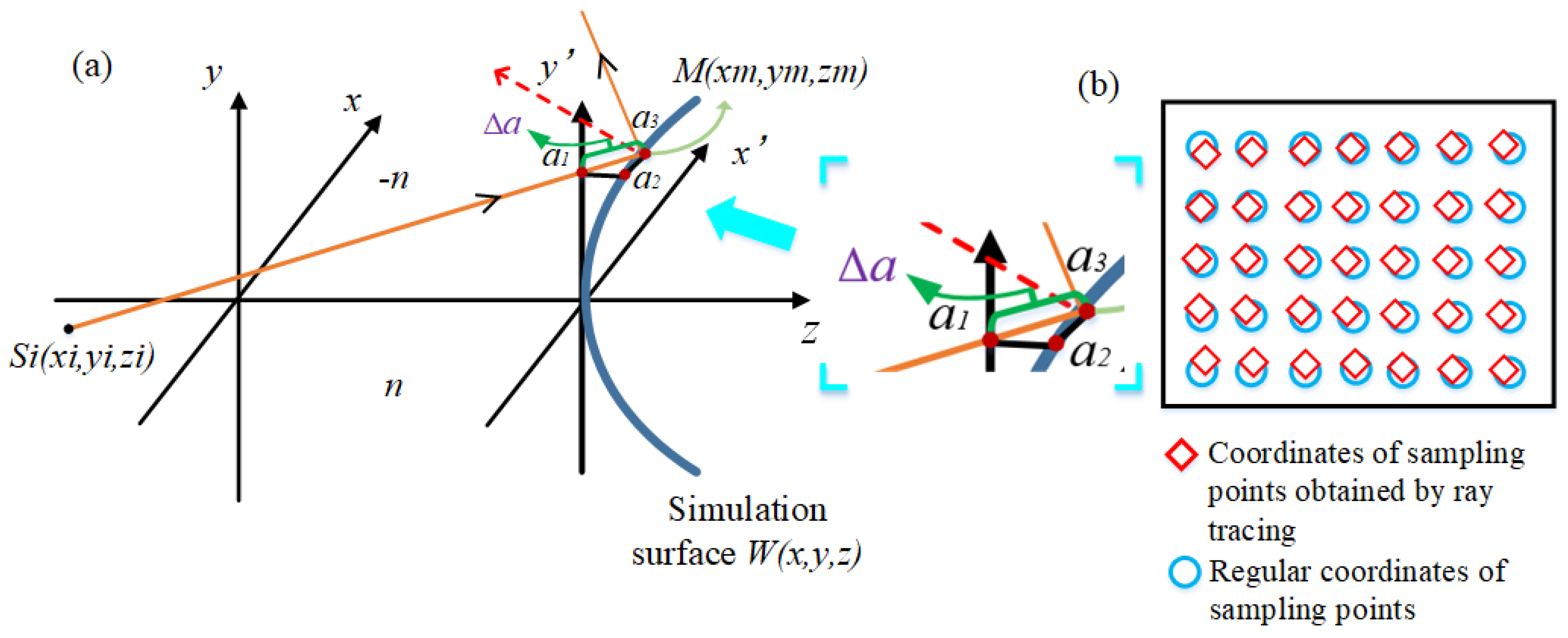
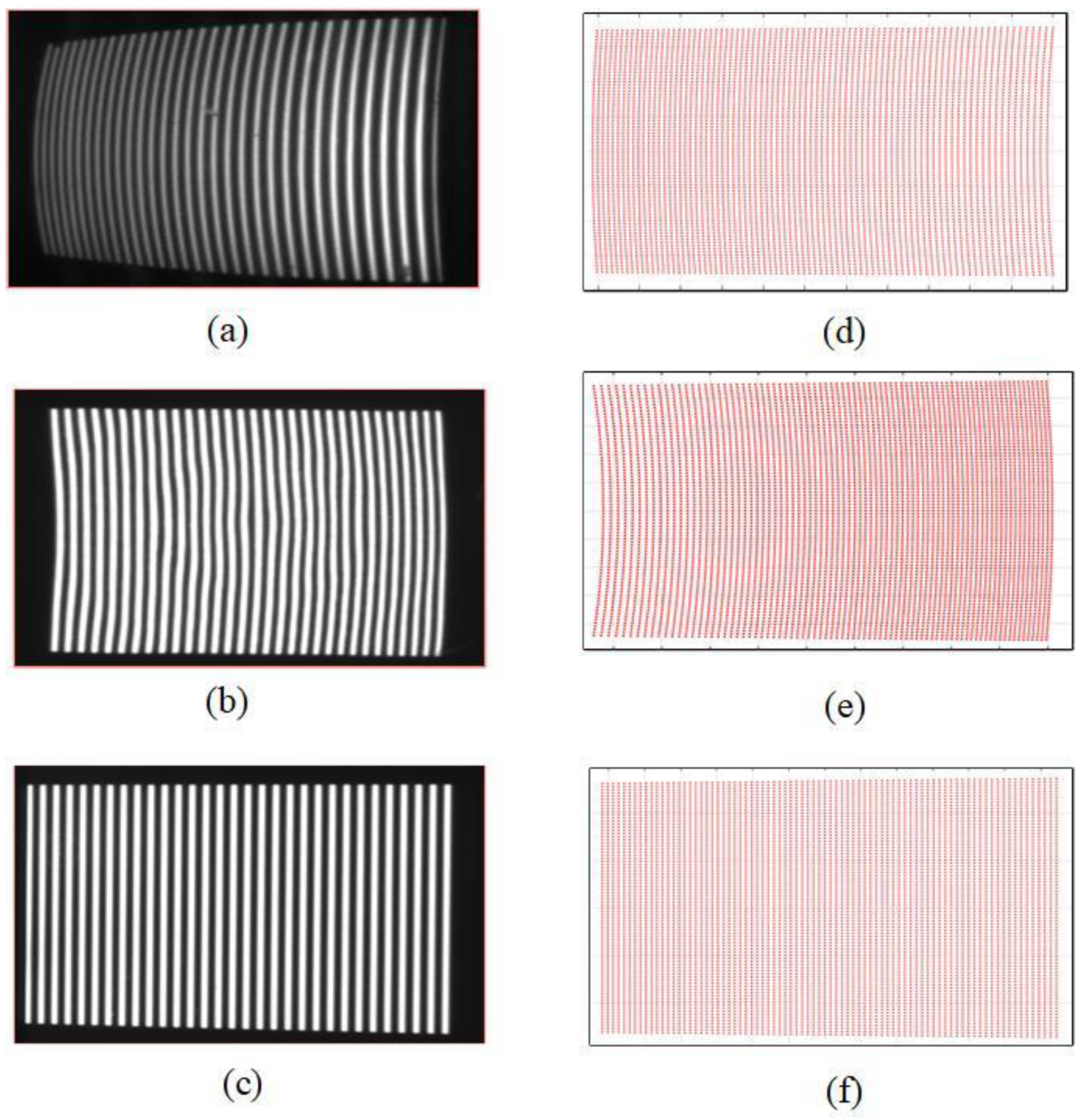
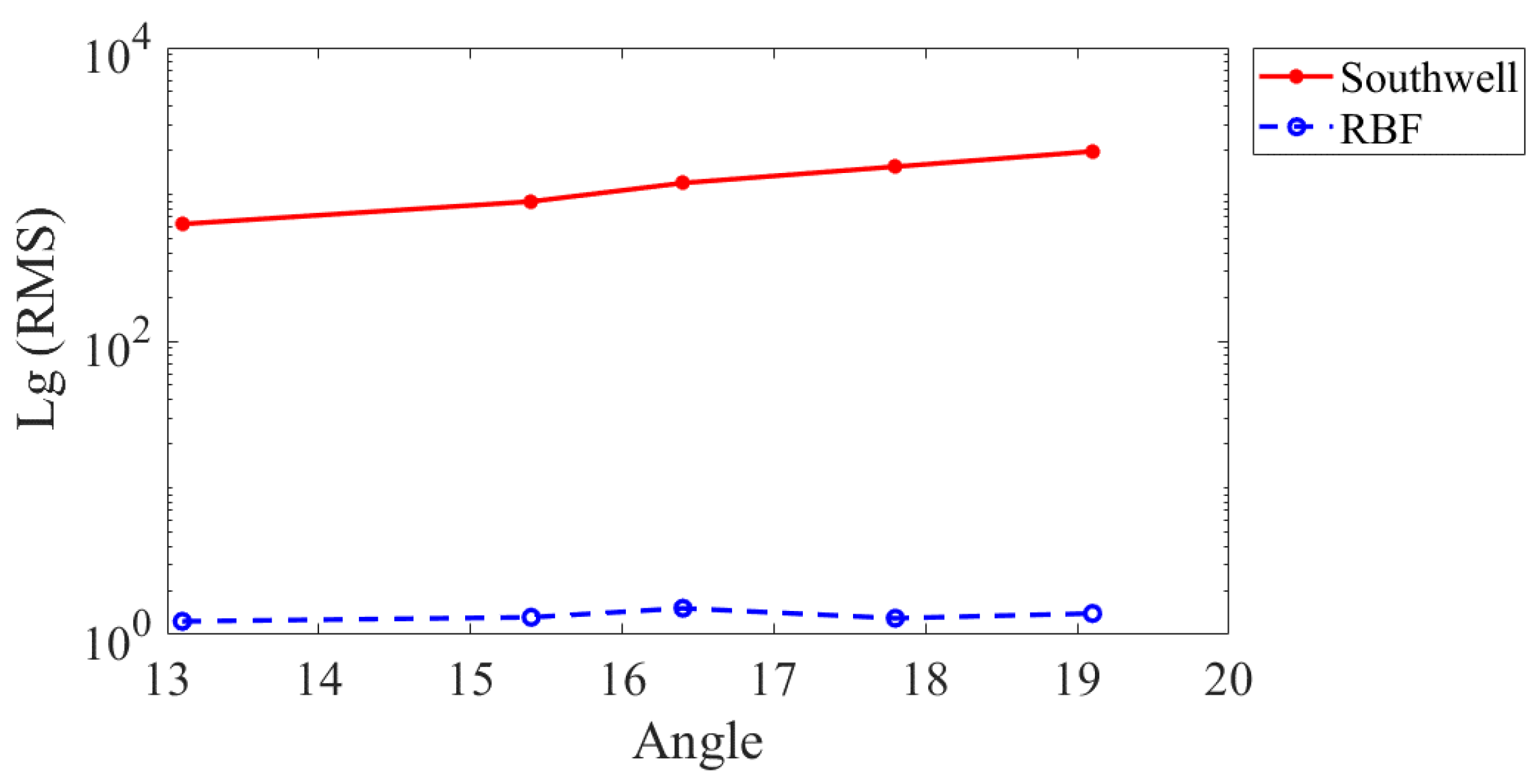
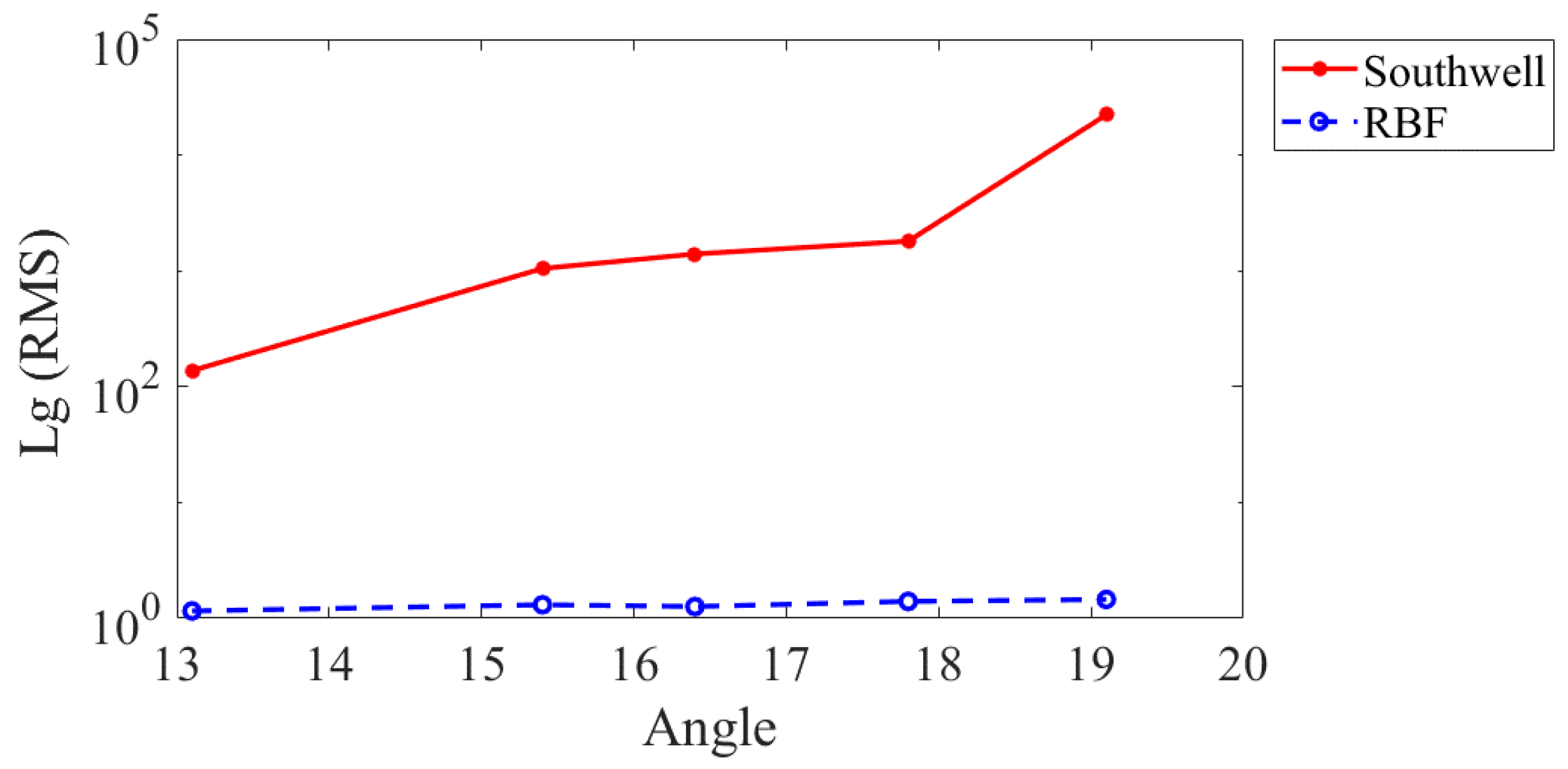
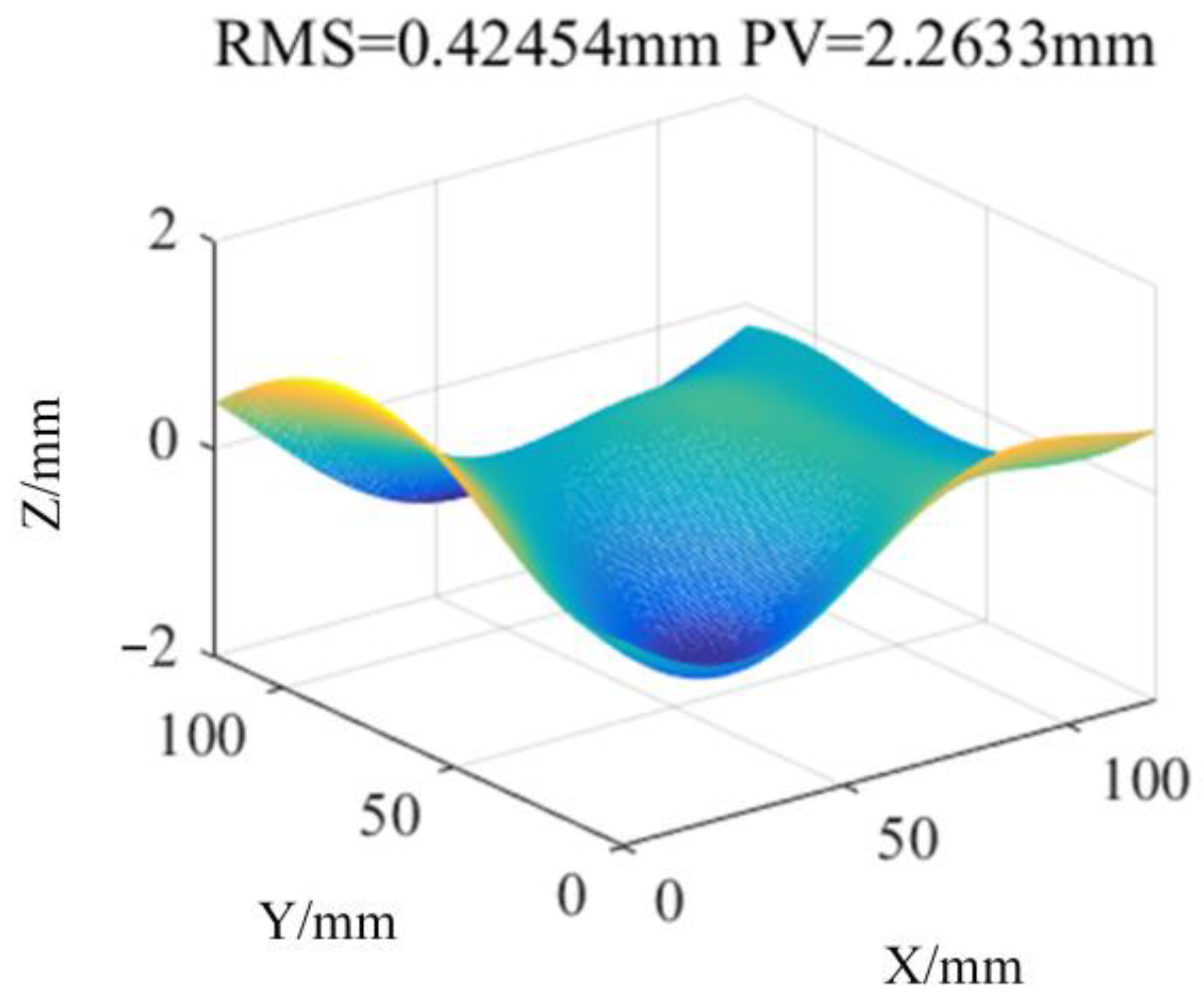
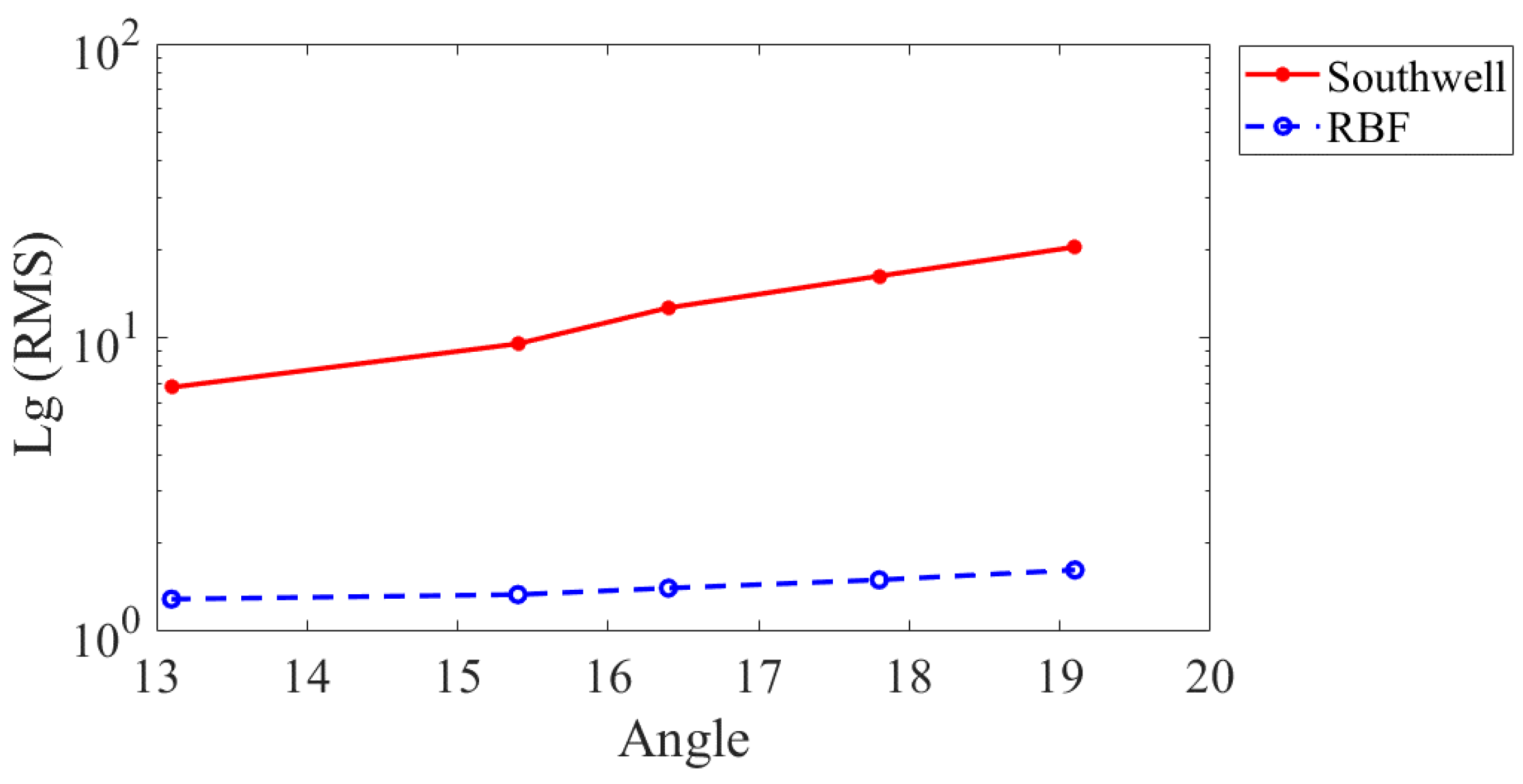
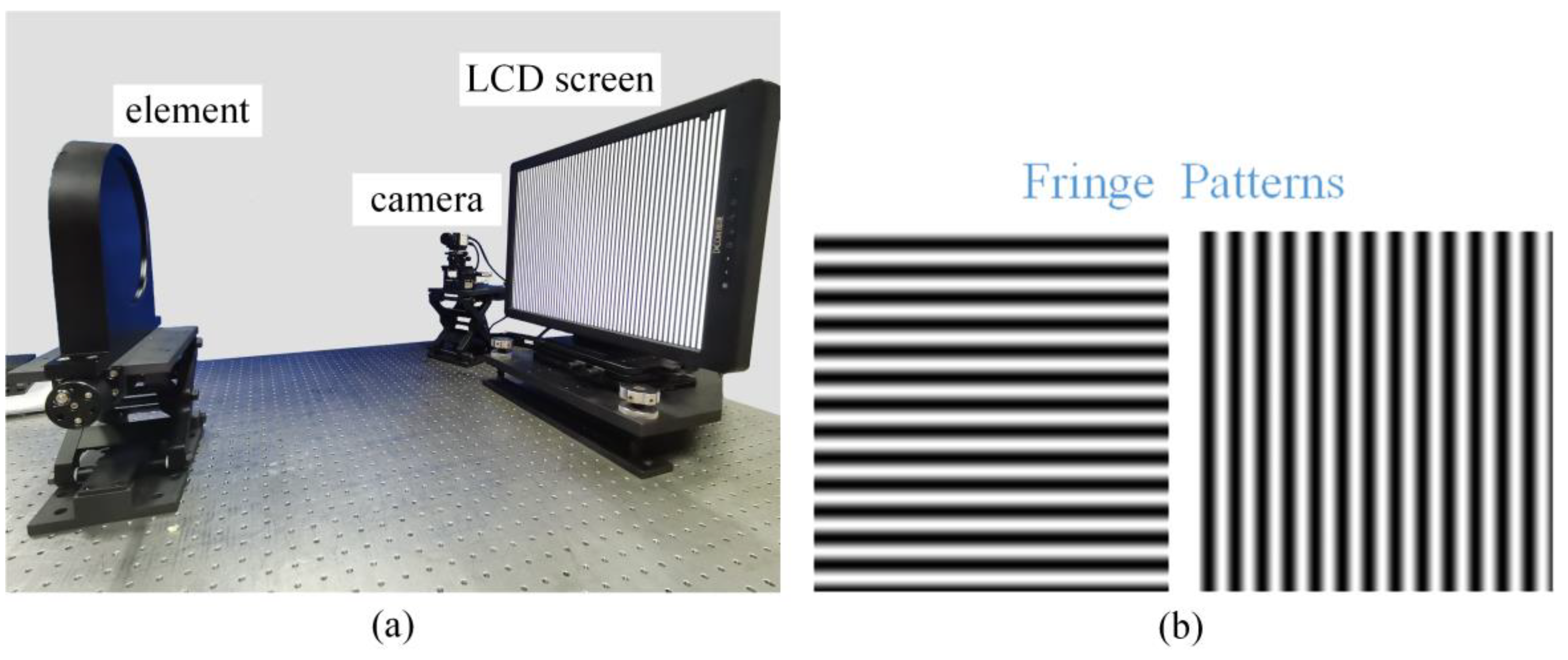
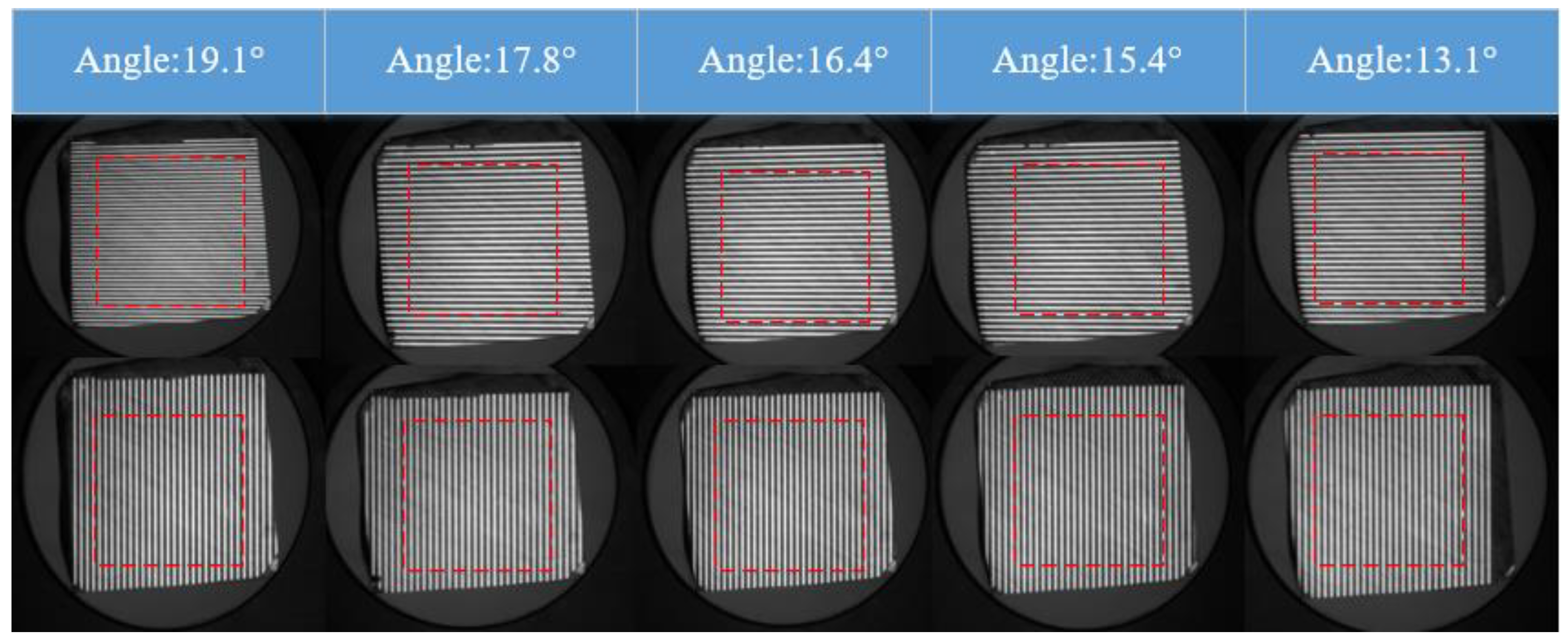
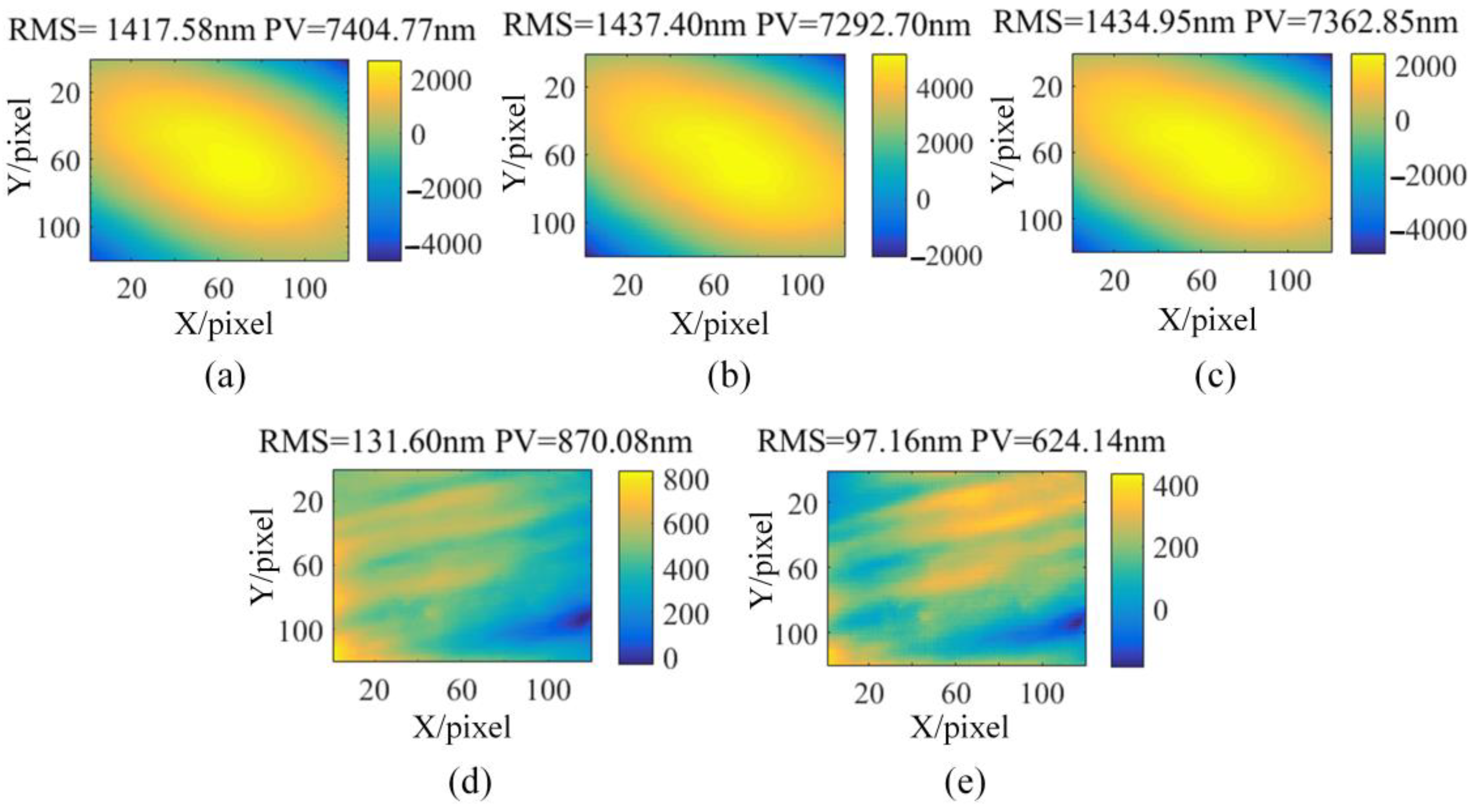
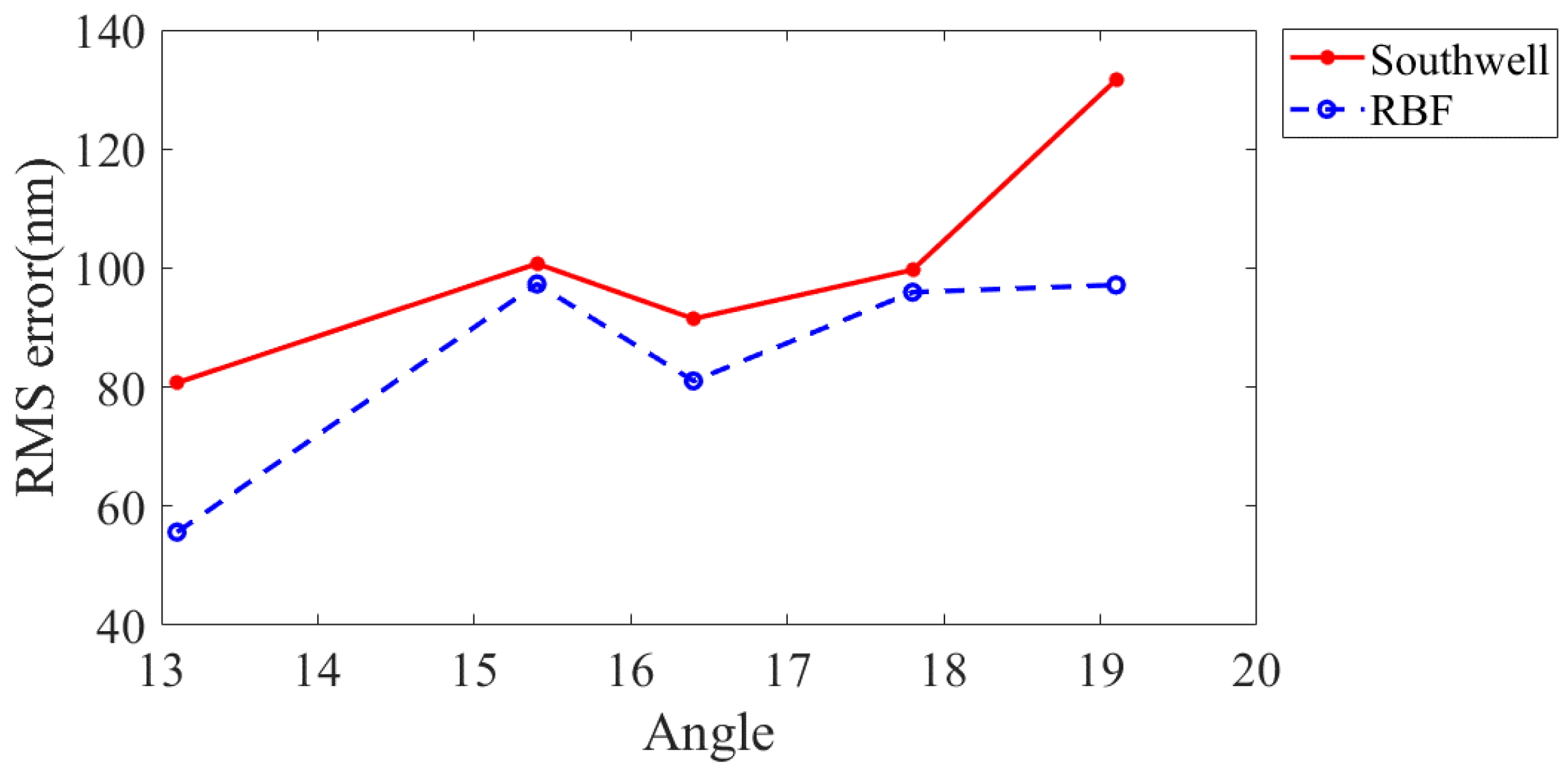
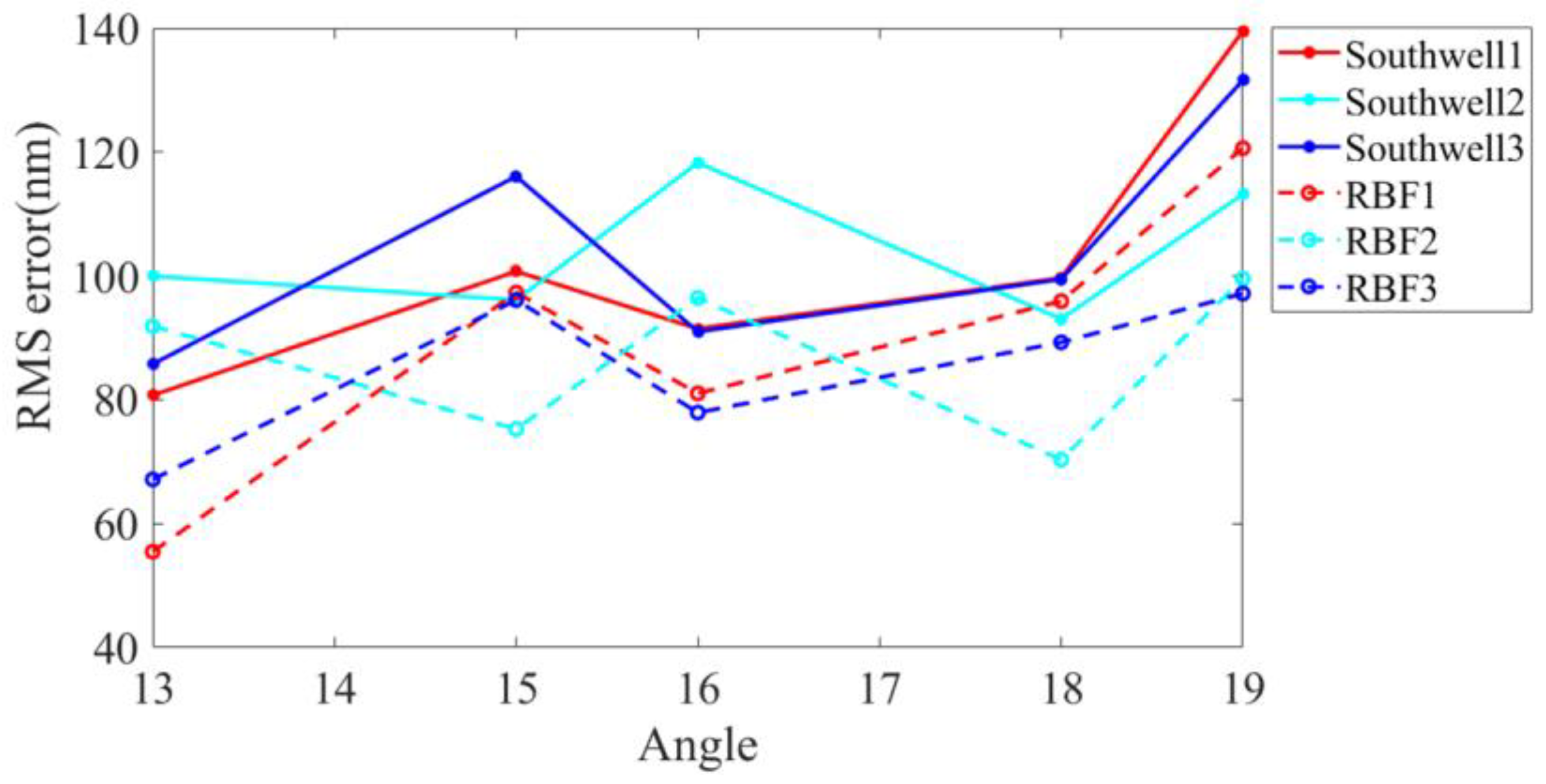
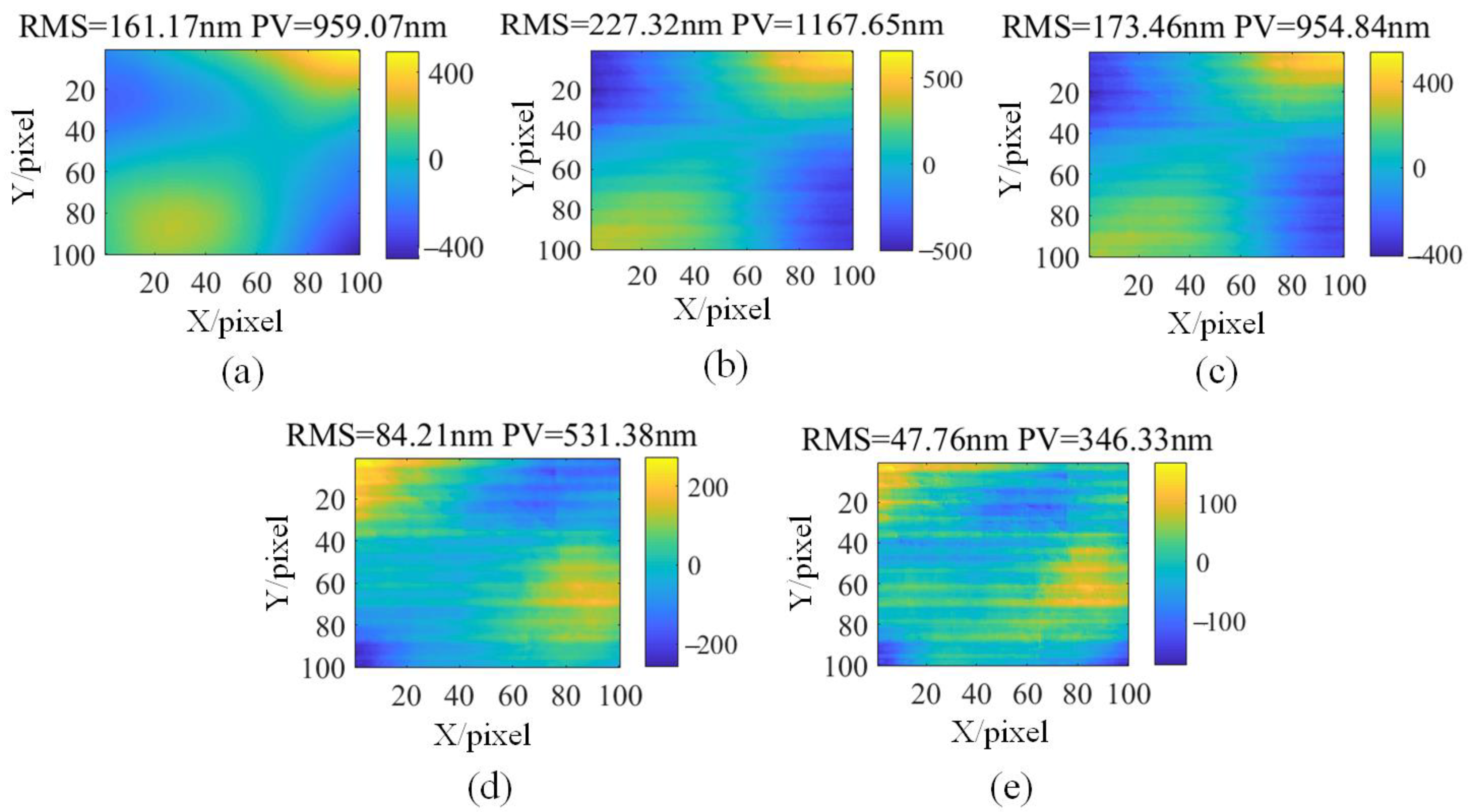
Disclaimer/Publisher’s Note: The statements, opinions and data contained in all publications are solely those of the individual author(s) and contributor(s) and not of MDPI and/or the editor(s). MDPI and/or the editor(s) disclaim responsibility for any injury to people or property resulting from any ideas, methods, instructions or products referred to in the content. |
© 2023 by the authors. Licensee MDPI, Basel, Switzerland. This article is an open access article distributed under the terms and conditions of the Creative Commons Attribution (CC BY) license (https://creativecommons.org/licenses/by/4.0/).
Share and Cite
Wang, H.; Li, D.; Zhang, X.; Ge, R.; Zheng, W. A Wavefront Integration Algorithm Based on Radial Basis Function for Off-Axis PMD. Appl. Sci. 2023, 13, 634. https://doi.org/10.3390/app13010634
Wang H, Li D, Zhang X, Ge R, Zheng W. A Wavefront Integration Algorithm Based on Radial Basis Function for Off-Axis PMD. Applied Sciences. 2023; 13(1):634. https://doi.org/10.3390/app13010634
Chicago/Turabian StyleWang, Heyan, Dahai Li, Xinwei Zhang, Renhao Ge, and Wanxing Zheng. 2023. "A Wavefront Integration Algorithm Based on Radial Basis Function for Off-Axis PMD" Applied Sciences 13, no. 1: 634. https://doi.org/10.3390/app13010634
APA StyleWang, H., Li, D., Zhang, X., Ge, R., & Zheng, W. (2023). A Wavefront Integration Algorithm Based on Radial Basis Function for Off-Axis PMD. Applied Sciences, 13(1), 634. https://doi.org/10.3390/app13010634






